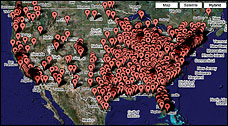
Well, and I just signed up for a federal tree planting program:
The Social Security numbers of tens of thousands of people who received loans or other financial assistance from two Agriculture Department programs were disclosed for years in a publicly available database, raising concerns about identity theft and other privacy violations.
Officials at the Agriculture Department and the Census Bureau, which maintains the database, were evidently unaware that the Social Security numbers were accessible in the database until they were notified last week by a farmer from Illinois, who stumbled across the database on the Internet.
“I was bored, and typed the name of my farm into Google to see what was out there,” said Marsha Bergmeier, president of Mohr Family Farms in Fairmount, Ill.
— U.S. Database Exposes Social Security Numbers By RON NIXON, New York Times, April 20, 2007
And she found not only her own farm and social security number on the web, but also 30,000 others. The Agriculture Dept. says probably 100,000 to 150,000 people are at risk. Ah, I see they’ve narrowed it to 38,700 people.
Continue reading
 Oh, this is too precious.
Oh, this is too precious.
